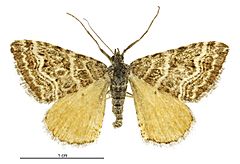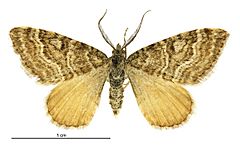Xanthorhoe bulbulata facts for kids
Quick facts for kids Xanthorhoe bulbulata |
|
|---|---|
 |
|
| Female | |
 |
|
| Male | |
| Conservation status | |
 Nationally Critical (NZ TCS) |
|
| Scientific classification | |
| Kingdom: | |
| Phylum: | |
| Subphylum: | |
| Class: | |
| Order: | |
| Family: | |
| Genus: |
Xanthorhoe
|
| Species: |
X. bulbulata
|
| Binomial name | |
| Xanthorhoe bulbulata (Guenée, 1868)
|
|
| Synonyms | |
|
|
The Xanthorhoe bulbulata is a special type of moth. It belongs to the Geometridae family, often called "looper moths." This moth is found only in New Zealand, meaning it is endemic there. Sadly, it is considered "critically endangered" by the Department of Conservation. This means it is at a very high risk of disappearing forever.
Contents
What is the Xanthorhoe bulbulata?
This unique moth was first officially described in 1868 by a scientist named Achille Guenée. Over time, other scientists studied it too. In 1883, Edward Meyrick placed it in the Larentia group. Later, in 1898, George Vernon Hudson moved it to the Xanthorhoe group, where it remains today.
Where does this moth live?
The Xanthorhoe bulbulata moth is native only to New Zealand. In the past, it lived all over the South Island. Records show it was found from the Awapiri area in the Awatere valley down to Invercargill.
What kind of places did it like?
These moths preferred "open, grassy places." They could be found from areas near the sea up to mountains, at heights between 660 and 930 meters (about 2,165 to 3,050 feet). People used to see them often between September and March.
Why is this moth disappearing?
Even though the Xanthorhoe bulbulata moth was common until the 1930s, it has become very rare. Since 1940, only two sightings have been officially recorded. One was a male moth seen flying in Queenstown in 1979. The other was a female caught in a special light trap near the Kawarau Gorge in 1991.
What efforts have been made to find it?
Between 1995 and 2000, scientists searched for this moth at 285 different locations. Despite all this effort, they did not find any more specimens.
What caused the decline?
Scientists believe the moth's decline is due to big changes in its natural homes. These changes happened after European settlers arrived in New Zealand. The habitats where the moths lived were altered, making it hard for them to survive.
How is the moth protected?
The Xanthorhoe bulbulata moth is listed as "Nationally Critical" under the New Zealand Threat Classification System. This is the highest level of threat. It means the moth is in extreme danger of becoming extinct in New Zealand. Protecting its remaining habitat is very important to help this species survive.

